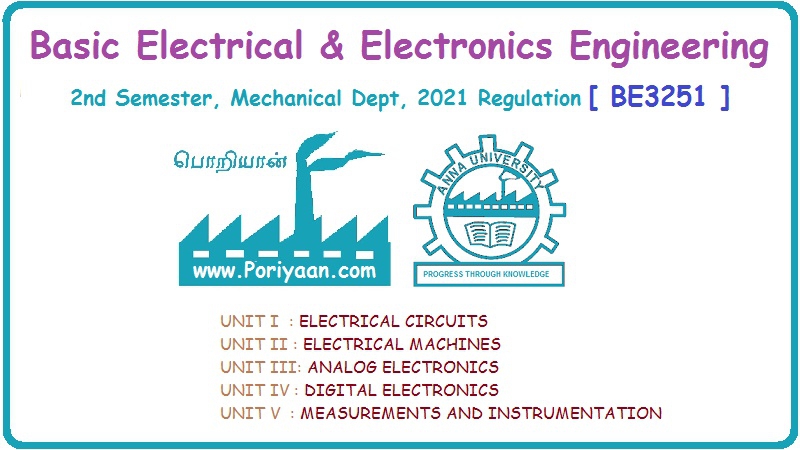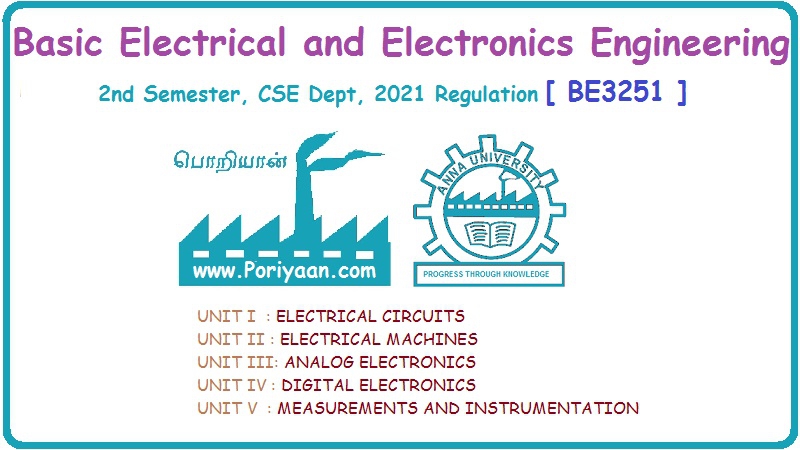Basic Electrical and Electronics Engineering: Unit III: Analog Electronics
PN Junction
Formation of Depletion Layer, Effect of Temperature, Biasing
We join a piece of P-type semiconductor to a piece of N-type semiconductor such that the crystal structure remains continuous at the boundary.
PN
JUNCTION
We
join a piece of P-type semiconductor to a piece of N-type semiconductor such
that the crystal structure remains continuous at the boundary as shown in
fig.3.19 a PN junction is formed. Such a PN junction forms a very useful device
and is called a semiconductor diode, PN junction diode (or) simply a crystal
diode.
PN
junction cannot be formed by simply joining (or) welding the two pieces.
together, because it would produce a discontinuous crystal structure. Special
fabrication techniques are used to prepare PN junctions.
Formation of Depletion Layer in a PN Junction
The
semiconductor consisting of a PN junction it is shown in Figure 3.20. It may be
noted that this entire sample is a single crystal. Its left half is a P-type
and the right half is N-type.
The
P-region has hole (as majority carriers) and negatively charged impurity atoms
called negative ions. The majority carriers in P and N region are not shown in
figure 3.20 for simplicity.
Holes
and electrons are mobile charges, and therefore called as mobile charge
carriers. On other hand positive and negative ions are immobile charges and do
not take part in the conduction. P-region, the total positive charge on the
holes is equal to the total negative charges on free electrons and immobile
ions. Similarly, in the N-region, the total negative changes on free electrons
is equal to the total positive charge on holes and immobile ions.
No
external voltage has been connected to the PN junction of figure 3.20. As soon
the junction is formed, the conduction and valence bands of P and N type
materials over cap. As a result of this the following processes take place.
(i)
The holes, from the P-region diffuse to the N-region, where they combine with
the free electrons.
(ii)
Free electrons, from the N-region diffuse to the P-region, where they combine
with holes.
(iii)
The diffusion of holes and free electrons takes place due to the reason that
there is a difference of concentrations in the two regions. i.e the P-region
has more numbers of free electrons. This difference in concentration creates a
concentration gradient across the junction. It results in the diffusion of
mobile charge carriers across the junction.
(iv)
The diffusion of holes and free electrons across the junction take place for a
short time. After a few recombinations of holes and free electrons, in the
vicinity of the junction, a restraining force is automatically setup. This
force is produced due to depletion region which exists on either side of the
junction.
The
recombination of free and mobile holes and electrons produce the narrow region
at the junction called depletion layer.
Junction (or) Barrier Voltage (VB)
The
depletion layer of a PN junction has no mobile charge carriers. But it contains
fixed rows of oppositely charged ions on its two sides. Because of this charge
separation, an electric potential (VB) is establish across the
junction, even when the junction is not connected to any external voltage
source as shown in Figure 3.21. This electric potential is called as junction
(or) potential barrier.
This
potential barrier exists a repelling force on the mobile charge carriers,
trying to cross over the junction, unless the energy is supplied from an
external source. At room temperature, the value of VB. VB
= 0.7 V for silicon and 0.3 V for germanium.
Effect of Temperature on Barrier Voltage
The
barrier voltage of a PN junction depends upon three factors namely density,
electronic charge and temperature. For given PN junction, the first two factors
are constant. Thus making the value of VB dependent only on
temperature. It has been observed that for both germanium and silicon the value
of VB decrease by 2 mv/°C. ΔVB - 0.002 × Δt
Where
Δt = increase in temperature in °C
Biasing the PN Junction
A
PN Junction, connected to an external voltage source is called a biased PN
junction. By applying external voltage across a PN junction, we are able to
control the width of the depletion layer.
Figure
3.22 Biasing the PN junction
This
allows us to control the resistance of the PN junction and also the amount of
current that can pass through the device.
There
are two ways of connecting voltage source to a PN junction.
(i)
Forward bias: In this case, positive terminal of voltage source is connected to
the P-side and negative terminal to the N-side as shown in Figure 3.22 (a). A
large amount of current flows through the junction under this condition.
(ii)
Reverse bias: In this case, positive terminal of the voltage source is
connected to the N-side and negative terminal to the P-side as shown in Figure
3.22 (b). Practically, no current flows through the junction under this condition.
Basic Electrical and Electronics Engineering: Unit III: Analog Electronics : Tag: : Formation of Depletion Layer, Effect of Temperature, Biasing - PN Junction
Related Topics
Related Subjects
Basic Electrical and Electronics Engineering
BE3251 2nd semester Mechanical Dept | 2021 Regulation | 2nd Semester Mechanical Dept 2021 Regulation
Basic Electrical and Electronics Engineering
BE3251 2nd Semester CSE Dept 2021 | Regulation | 2nd Semester CSE Dept 2021 Regulation

